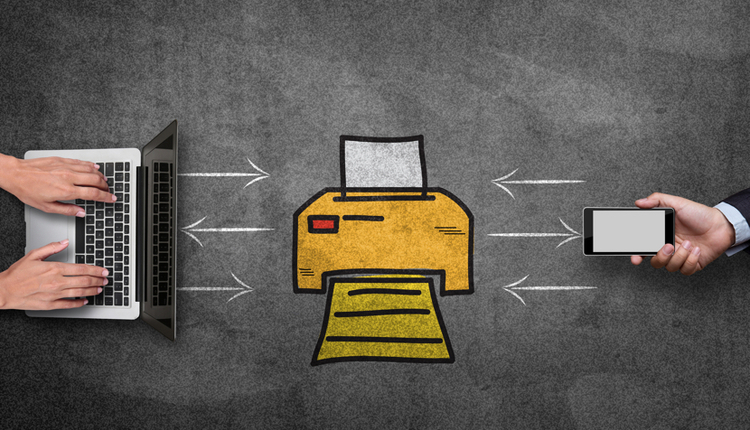It was more than 10 years ago when I visited what was, at the time, a state-of-the-art imaging facility for a national insurance company, progressive beyond their peers and before the anthrax-in-the-mail scare. The head of document imaging was giving me the grand tour and explaining how thousands of claims adjusters and billing professionals were able to improve the efficiency of their operations with digitized workflows and online forms, a true automated operation that would have been the envy of many other corporate offices anywhere. It was, without question, a model for taking the cost and time out of the document workflow associated with claims processing. After the claims tour, he proudly led me to see one of the first "digital mailrooms," replete with a dozen Bell + Howell production scanners and serious and efficient mailroom operators opening and scanning every single piece of mail that went into the facility for the 5,000-plus workers engaged there.
We then proceeded through the typical cubicle jungle to get to our corporate conference room to meet with some other managers. On the way down one of the aisles, I could not help but notice that there were stacks and stacks of paper in many of the cubes, often obscuring the view for the workers themselves. I turned to my host and said, "Hey Bill (fictitious name), what's with all the paper?" He shuffled his shoes and looked down as he sheepishly replied to me, "They all seem to print their mail."
The example is not an isolated incident of good technology begetting bad behavior, but more common even today, 10 years later, than many ECM professionals would like to admit. In spite of incredible advances in technology for creating, managing, viewing and storing documents online and in only a digital form, most of us are disinclined to give up much, if any, of the paper we know and love. As a frequent business traveler and observer of other road warriors, in spite of the sexiness and fun of our iPads, Droid tablets and phones, most business fliers still pull out a collection of files for review in between their movies and paltry airline snacks.
Why would that be, you ask? How about my favorite truism that my paper never needs a charge and never runs out of batteries? The airlines also do not make me turn off my notepad or newspaper for takeoffs and landings, and I, therefore, calculate I gain an extra 20 to 30 minutes per trip of productivity. As we all know, depending on the airport, it can be more like 30 to 45 minutes, easily depending on the airport (JFK gives you time to cover at least the business and sports sections).
Doesn't technology reduce the paper?
More people are scanning their paper. According to Susan Moyse of the Moyse Report on Document Capture, the desktop and workgroup scanners category grew 31% last year (240,000 units in 2011) and departmental scanners also did well—growth of 12% to 180,000 shipments last year.
According to a recent study of 395 business users by the ECM trade association, AIIM International, "While the exchange of PDF files as email attachments has reduced the volume of paperwork traded between IT professionals, that reduction is not only minimal, but quite possibly made up for. Over three-quarters of IT professionals surveyed say one of the first things they do with a PDF-based invoice [...] is print it out."
"And after those 77% of respondents print out their invoices, some 16% then scan them right back into the system for use as PDF attachments [...] some 77% of whose recipients print them right back out again."
So, why go paperless anyway? According to the 2002 report from Green Seal Inc. (with data from the EPA), 24 trees are cut down to make a ton of (virgin) printing and office paper. However, a ton of paper made from 100% recycled paper, as compared to virgin paper, saves the equivalent of 4,100 kilowatt-hours of energy, 7,000 gallons of water, 60 pounds of air emissions and three cubic yards of landfill space.
In spite of the seemingly endless piles of paper everywhere we look, the AIIM study found some encouraging trends compared to the same study they did in 2009. They cite the net decrease of 15% of the largest organizations with declining volumes of paper, probably the result of wider use of scanning and capture technologies, as well as green initiatives. The SMB market, however, seems to be stuck in neutral, perhaps due to a lack of investment or lack of scale maybe to feel the pain or the gain of making significant improvements.
The Federal Government made a serious attempt in 1995 with the Paper Reduction Act that, among other requirements, mandated two-sided printing and electronic documents where ever possible. However, the same government gave us other, and perhaps offsetting, mandates, including HIPAA, Sarbanes-Oxley and the Patriot Act, requiring more and more paper to print, manage and store.
The proliferation of electronic devices, such as eReaders and tablets, will no doubt soak up some of the information formerly occupied by paper. IDC reports the 68.7 million tablets shipped in 2011 represents a 9% increase from IDC's forecast of 63.3 million and is about 3.5 times the 19.4 million shipped in 2010. The significance to this data is the general consensus that the tablet is a device optimized for the consumption of and not the creation of media. It will take other changes in the business end of how we distribute information, however, if we are to realize the full benefits of the shift in technology. In fact, the courts are reviewing the pricing practices of how eBooks are priced today, based on the Apple model that was more than appealing to publishers but maintained artificially higher prices, discouraging aggressive retailers like Amazon.com from selling the books at steep discounts as they do printed books today. Customers justly ask the question, "Why should I pay more for a download than a tree-killing, paper and ink version of a book?" A fair question indeed.
If the past is any indication of the future (and it often is), we are unlikely to see any significant changes to the paper in the office dilemma anytime in the near future. It may be as the unnamed document imaging philosopher once famously said, "The paperless office will be here about the same time as the paperless bathroom."
DON F. MCMAHAN is the managing director of McM Consulting, a sales and marketing, business strategy consultancy and the former VP of Sales for Eastman Kodak, Fujitsu, Visioneer document imaging divisions. He has spent more than 20 years managing channels and growth in the ECM industry and is also the past chair of AIIM international and a member of the AIIM Company of Fellows.





![GettyImages-1211616422-[Converted]](https://cms-static.wehaacdn.com/documentmedia-com/images/GettyImages-1211616422--Converted-.2413.widea.0.jpg)


